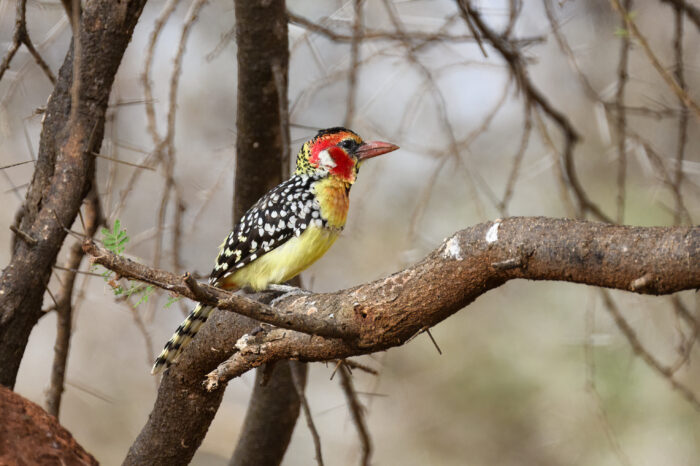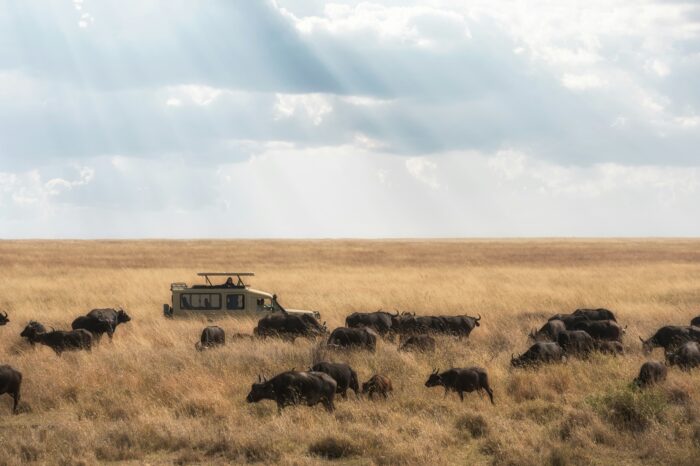Tanzania Endemics Birding Tour
Embark on an extensive Tanzania birding tour in pursuit of the country’s extensive array of endemic species. Carefully crafted, this birdwatching trip is tailored to highlight the finest of Tanzania, with a special emphasis on its remarkable endemic birds.
Ranking second only to the DRC, Tanzania boasts one of Africa’s most extensive species lists. Consider this: 1,155 unique bird species, encompassing 800 resident birds and 200 migrant species. Furthermore, Tanzania houses 43 endemic species exclusive to its territory, alongside an additional 53 near-endemic species found in Tanzania and neighbouring regions. If these staggering numbers have not piqued your interest, then I am not sure what will!
*This tour can be organised as a private, tailor-made tour. Alternatively, please refer below for our scheduled group tour dates and associated costs.
Day 1: Pick-up from Kilimanjaro International Airport
On arrival at Kilimanjaro International Airport, a Sustainable Birding representative will meet you at arrivals and do a quick meet and greet, before transferring you to your hotel in Arusha, so you can relax and get some sleep ready for a great adventure ahead.
Where you will be staying: Rivertrees Country Inn
Day 2: Arusha National Park
A short drive from Kilimanjaro International Airport leads us to the Arusha National Park, where our mega trip commences. This diverse park highlights a stunning array of landscapes, encompassing vast savannahs, lush rainforests, acacia woodlands, and ascending to alpine vegetation on Mount Meru’s higher slopes. Upon arrival, our safari vehicle will traverse the park while we indulge in birdwatching along the way. Exploring certain areas on foot for birding will undoubtedly be a highlight. With its rich blend of wildlife and bird species, Arusha National Park sets an exhilarating tone for our tour.
Where you will be staying: Rivertrees Country Inn
Day 3: Lark Plains
On our third day, we are set to explore Lark Plains, an area renowned for the elusive Tanzania endemic, Beesley’s Lark. These arid plains serve as a magnet for a diverse range of specialized avifauna adapted to dry environments, promising extensive on-foot birding opportunities. Although typically dry year-round, these plains witness substantial downpours from March to May, triggering rapid vegetation growth and attracting numerous passerines, raptors, and ground-dwelling species. Amidst our search for the Tanzania endemic, we will also keep an eye out for near-endemic species like the Athi Short-toed Lark, Red-throated Tit, and Short-tailed Lark, among other notable bird species.
Where you will be staying: Rivertrees Country Inn
Day 4: Tarangire National Park
Our next destination is the stunning Tarangire National Park. Abundant in both impressive game and diverse avifauna, this leg promises an unforgettable experience. The park derives its name from the perennial Tarangire River, a vital lifeline for the surrounding wildlife, particularly during the dry season when vast herds of wildebeest, zebra, and other animals gather here. Renowned for its scenic beauty and rich avian diversity, with a recorded count of over 500 species, we are eager to compile an extensive bird checklist within a brief period.
Species highlights: Ashy Starling, Red-and-yellow Barbet, Red-bellied Parrot, Von der Decken’s Hornbill, White-headed Buffalo-weaver, Vulturine Guineafowl, Yellow-collared Lovebird, Bare-faced Go-away bird, Donaldson Smith’s Nightjar, Northern Pied Babbler, Northern White-crowned Shrike to name a few.
Where you will be staying: Tarangire Simba Lodge
Days 5 & 6: Serengeti
Our next stop introduces you to Africa’s most iconic national park – the Serengeti. Renowned for a reason, this expansive ecosystem stands as one of the world’s last untamed wilderness areas. Endless plains stretch as far as the eye can see, hosting vast congregations of mammals, making it an unparalleled spectacle. The park’s crowning glory is the legendary Wildebeest Migration, where over 1.5 million wildebeest traverse the plains, following the life-giving rainclouds that nourish the grasslands below. This incredible phenomenon alone is bound to capture your heart. However, the avian diversity in this park is equally extraordinary, with over 500 recorded species. Among them are the endemic Grey-breasted Spurfowl and numerous near-endemics like the Abyssinian Wheatear, Red-throated Tit, Rufous-tailed Weaver, and Grey-crested Helmetshrike. Our birding checklist will also include sought-after species such as the White-crested Helmetshrike, Meyer’s Parrot, Yellow-throated Longclaw, and Zitting, Croaking, Desert Cisticolas, White-headed and Black Sawwings, and Paradise, Pin-tailed and Straw-tailed Whydahs.
Spending two immersive days slowly traversing this vast wilderness, we will soak in every aspect of its unparalleled beauty and wildlife.
Where you will be staying: Acacia Central Camp
Day 7: Transfer to Arusha (birding along the way)
On Day 7, we embark on a return journey to Arusha, marking the transition to the next segment of our adventure – the endemic-rich Northeastern Tanzania. Our drive back to Arusha will be leisurely, allowing us to indulge in birdwatching opportunities along the route
Where you will be staying: Rivertrees Country Inn
Days 8 & 9: South Pare Mountains
Our next destination is a short drive to the captivating South Pare Mountains, in pursuit of two endemic treasures—the South Pare White-eye and Usambara Double-collared Sunbird. Amidst our quest for these endemics, we will keep our eyes peeled for other regional specialties like the Bar-throated Apalis, Hunter’s Cisticola, Purple-banded Sunbird, and East Coast Boubou.
This scenic destination offers not just exciting bird targets but also breathtaking landscapes. We’ll savour our time here, absorbing the stunning scenery while enriching our already extensive bird checklist.
Where you will be staying: Johnsons Villas
Days 10, 11 & 12: Usambara Mountains, Western Usambara Range
On our ninth day, we venture into the awe-inspiring Usambara Mountains, starting our exploration from the West Usambara range. These mountains, formed around 2 million years ago, are integral parts of the Eastern Arc Mountains, extending into Kenya. Renowned as one of Africa’s crucial conservation sites for globally threatened birds, this area shelters an astounding diversity, boasting seven endemic species—Usambara Eagle-owl, Usambara Hyliota, Usambara Thrush, Usambara Weaver, Usambara Akalat, Usambara Greenbul, and Usambara Tailorbird. Additionally, it hosts seven near-endemics, including the Sokoke Scops Owl, Long-billed Tailorbird, Amani Sunbird, Usambara Double-collared Sunbird, Taveta Golden-Weaver, Spot-throat, and Dapple-throat.
Where you will be staying: Mullers Mountain Lodge
Days 13, 14 & 15: Usambara Mountains, Eastern Usambara Range
Over the next few days, we will be exploring the East Usambara range, including Amani Forest Reserve, where our focus will be on regional species. Among the species on our checklist are the Ayres’s Hawk-eagle, Southern Banded Snake Eagle, Purple-banded Sunbird, Amani Sunbird, Uluguru Violet-backed Sunbird, Green Barbet, Spotted Eagle-owl, Usambara Eagle-owl, Half-collared Kingfisher, Gorgeous Bushshrike, and more. Additionally, we will be in search of two endemic species of this region – Usambara Hyliota and Usambara Tailorbird.
Where you will be staying: Amani Forest Camp
Days 16, 17 & 18: Pemba Island
The following morning, we will be driving to the coastal town of Tanga for a domestic flight to the tropical paradise of Pemba Island. Upon our midday arrival, prepare to bask in some of the world’s finest white sand beaches. Unlike its more frequented neighbour, Zanzibar, Pemba Island receives fewer annual visitors, preserving its pristine allure. At times, you’ll relish the sensation of having the entire island to yourself – an experience totally unique. Pemba Island, teeming with endemics, promises an unforgettable stay.
Our time here will be leisurely as we seek three endemic species- the Pemba Sunbird, the Pemba White-eye, and the elusive Pemba Scops Owl. We will also have the pleasure of encountering the endemic Pemba Vervet Monkey, recognized as a distinct subspecies from its mainland relative. A visit to Ngezi Forest offers the opportunity to spot the splendid Pemba Green Pigeon and a good chance to observe the rare Pemba Flying Fox, a fruit bat exclusive to the island.
Where you will be staying: The Nautilus
Days 19, 20 & 21: Uluguru Mountains Forest Reserve
Our next destination brings us to the stunning Uluguru Mountains, an astounding hotspot for endemism. Spanning a remarkable array of habitats – from montane and submontane to grasslands and swamplands – these mountains contain four endemic bird species, eleven reptile endemics, two mammal endemics, and an astonishing twenty-six endemic plant species. Describing this place as exceptional would be an understatement.
Over the course of three days, we will transect the reserve, focusing on the bird endemics such as the Uluguru Mountain Greenbul, Mrs. Moreau’s Warbler (Winifred’s Warbler), Loveridge’s Sunbird, Uluguru Violet-backed Sunbird, Uluguru Bush-shrike, and various other rare and localised bird species. It is a treasure trove for birdwatchers, promising remarkable sightings.
Where you will be staying: Edelwyss-inn
Days 22 & 23: Ukaguru Mountains & Rubeho Mountains
Our next destination leads us to the vast expanse of the Ukaguru Mountains, a colossal plateau stretching across 1258 km2 (480 m2) characterized by exceptional biodiversity and high endemism in flora, fauna, and avifauna. This area, recognised as an Important Bird Area (IBA), is home to two sought-after bird endemics – the Rubeho Warbler and Rubeho Forest Partridge. Featuring diverse habitats like Miombo woodlands, montane forest, grasslands, and open woodland, exploring this expansive plateau promises an exciting and fulfilling day.
The following morning, we will venture to the nearby and less-visited Rubeho Mountains, which sit adjacent to the Ukaguru Mountains, separated by the Mkondoa River. Designated as an IBA, this range boasts four endemic species – the Rubeho Akalat, Rubeho Double-collared Sunbird, Rubeho Warbler, and Rubeho Forest Partridge, alongside numerous near-endemics, and localised species. Our primary focus will be on adding these unique species to our ever-expanding checklist
Where you will be staying: Nguzo Campsite Lodge
Day 24: Kilombero Swamp and Ramsar site
The following day, our itinerary takes us to the Kilombero Swamp, situated within the Kilombero Flood Plain. This globally important wetland site houses a remarkable array of threatened flora and fauna, encompassing around 350 plant species and hosting a diverse birdlife of 300 species. Among them are three endemics – the Kilombero Weaver, Kilombero Cisticola, and White-tailed Cisticola – our primary targets for this visit. Additionally, the swamp is home to 75% of the world’s Puku population, which will be a nice extra.
Where you will be staying: Hondo Hondo – Udzungwa Forest Tented Camp
Days 25 & 26: Udzungwa Mountains National Park
Over the upcoming days, we will explore the Udzungwa Mountains National Park – an impressive sanctuary hailed as Africa’s second most diverse national park. Situated in the eastern arc, this park, an Important Bird Area (IBA), boasts a staggering 400 bird species, including two endemics – the Udzungwa Forest Partridge and Rufous-winged Sunbird – alongside numerous near-endemics. The park also highlights incredible biodiversity with 2,500 plant species, a quarter of which are endemic, and a rich array of primates, including six species with five being endemic, notably the Sanje Mangabey and Udzungwa Red Colobus. The diverse habitats range from tropical rainforests to montane forests, grasslands, steppe, and Miombo woodlands.
The birdlife in the Udzungwa Mountains is unparalleled, making it an absolute must-visit for avid birders. If time permits, we will also explore the nearby Magombera Forest in search of the elusive Pel’s Fishing Owl and Lesser Seedcracker.
Where you will be staying: Hondo Hondo – Udzungwa Forest Tented Camp
Day 27: Iringa Highlands
In the upcoming days, we’ll be birdwatching across the picturesque Iringa Highlands, nestled within Tanzania’s Southern Highlands—a region known for its remarkable diversity. Our approach will be unhurried as we meander through this stunning landscape. Our primary focus will be on locating the endemic species such as the Iringa Akalat, Kilombero Weaver, and Kipengere Seedeater, among a plethora of other localized species that call this area home.
Where you will be staying: Mufindi Highland Lodge
Days 28 & 29: Mikumi National Park
As we approach the final days of our tour, we will journey back up north to explore Tanzania’s fourth largest national park—the breath-taking Mikumi National Park. This park shares borders with the Selous Game Reserve to the south, forming a unique and vital ecosystem. Additionally, it neighbours the Udzungwa and Uluguru Mountains, which we have recently visited.
The landscape of Mikumi is often likened to the iconic Serengeti, boasting sweeping savannahs and grasslands. Abundant in large mammals and picturesque bird species, it’s a haven for photography enthusiasts. Exploring Mikumi promises to be a delightful conclusion to our unforgettable birding tour of Tanzania.
*For those interested, there is an option to extend the tour by spending a few additional days in the outstanding Selous Game Reserve. Please let us know if this extension appeals to you
Where you will be staying: Stanley’s Kopje Camp
Tour pace:
Slow/medium – this tour was designed to be impactful, gaining a large count of endemics and regional species within one month.
Tour difficulty:
Easy/Medium – a lot of on-foot birding but nothing overly strenuous. Walking boots are essential.
Deposit:
We’d we need a 25% deposit to secure your place on this tour.
Cost:
The above cost is based on a group of 6 people. Please get in touch if you’d like us to arrange a private tailor made tour.
Single supplement:
£2,400
Best time of year to visit:
Prime birding season in Tanzania falls during the short rains of November and early December. This period showcases most species in vibrant breeding plumage, featuring captivating display behaviours of whydahs, widowbirds, and bishops. Additionally, it’s when numerous Palearctic migrants make their presence felt, so the count will be high.
Sustainability:
At Sustainable Birding, our goal is to ensure that every birding holiday we create contributes positively to bird conservation efforts and local communities. Our determination to promote sustainable travel led us to become founding members of Tourism Declares Climate Emergency. As part of this commitment, we have established the world’s pioneering carbon scoring and offsetting framework for tailor-made holidays. Feel free to request us to carbon score your individual trip!
Tour Leader:
Issac is an avid birder, sound recorder, bird photographer, and field guide with a rich background in ornithology. Over the years, he has actively engaged in various citizen science projects, lending his expertise to bird mapping, nest watch programs, waterbird counts, and bird exploration expeditions. His insights have not only shaped co-authored semi-scientific papers but have also established him as a respected authority in the field.
In addition to his roles as a dedicated bird enthusiast, Issac played a pivotal role in founding the Tanzania Birders Community and the Kilusu Bird Club. These organizations have successfully united bird lovers across Tanzania, creating a collaborative space for participation in large-scale mapping projects. Issac introduced the innovative use of the Ebird app within the community, enhancing data collection efficiency and fostering widespread data sharing among members.
Issac’s passion for avifauna extends to his expertise as a bird sound recordist. His comprehensive collection of over 2300 bird sounds, meticulously cataloged on www.xeno-canto.org, stands as a testament to his dedication and keen ear. Many of these recordings have been instrumental in the development of cutting-edge birding applications, captivating birding enthusiasts globally.
Contributing to www.orniverse.com, Issac expertly describes and guides individuals through the breathtaking birding sites of Kenya and Tanzania. With nine years of invaluable experience as a field guide, he has led numerous successful birding tours, showcasing the expansive natural landscapes and diverse avian species found across Kenya and Tanzania. Issac’s knowledge, passion, and eagerness to share his expertise have made him a sought-after guide for those embarking on immersive birding experiences.
In summary, Issac is a dedicated bird enthusiast, versatile bird sound recordist, knowledgeable field guide, and accomplished bird photographer. His unwavering love for avian life and commitment to furthering citizen science significantly contribute to the understanding and conservation of birds in East Africa and beyond.

Bird species highlights:
- Beesley’s Lark
- Athi Short-toed Lark
- Red-throated Tit
- Short-tailed Lark
- Ashy Starling
- Red-and-yellow Barbet
- Red-bellied Parrot
- Von der Decken’s Hornbill
- White-headed Buffalo-weaver
- Vulturine Guineafowl
- Yellow-collared Lovebird
- Bare-faced Go-away bird
- Donaldson Smith’s Nightjar
- Northern Pied Babbler
- Northern White-crowned Shrike
- Grey-breasted Spurfowl
- Abyssinian Wheatear
- Rufous-tailed Weaver
- Grey-crested Helmetshrike
- White-crested Helmetshrike
- Meyer’s Parrot
- Yellow-throated Longclaw
- Zitting Cisticola
- Croaking Cisticola
- Desert Cisticola
- White-headed Sawwing
- Black Sawwing
- Paradise Whydah
- Pin-tailed Whydah
- Straw-tailed Whydah
- Pemba Sunbird
- Pemba White-eye
- Pemba Scops Owl
- Pemba Vervet Monkey
- Pemba Green Pigeon
- Pemba Flying Fox
- Uluguru Mountain Greenbul
- Mrs. Moreau’s Warbler (Winifred’s Warbler)
- Loveridge’s Sunbird
- Uluguru Violet-backed Sunbird
- Uluguru Bush-shrike
- Rubeho Warbler
- Rubeho Forest Partridge
- Kilombero Weaver
- Kilombero Cisticola
- White-tailed Cisticola
- Udzungwa Forest Partridge
- Rufous-winged Sunbird
- Iringa Akalat
- Kipengere Seedeater
-
DepartureArusha
-
Departure Time20th November 2024
-
Return Time19th December 2024
-
IncludedAirport transfers.Private safari 4WD Toyota Land Cruiser with a 'pop-up' roof!Return domestic flight from Tanga to Pemba IslandAccommodation as shown based on twin room. Single supplement available.Full-board basis (breakfast, lunch & dinner).All national park entrance fees.Professional English-speaking guide/driver.Mineral water in the vehicle.Wi-fi in the vehicle.Medical emergency evacuation cover.
-
Not IncludedInternational flightsOptional activities unless specified as included.Excess baggage charges.Soft drinks & alcoholic beverages.Visas.
Similar Tours

Best of Northeastern Tanzania & Usambara Mountains
This Tanzania birding tour has been meticulously designed to offer you an unparalleled experience in the breath-taking North-eastern region of Tanzania. This area boasts some of Tanzania’s most exceptional birding locations.

Serengeti, Ngorongoro Crater & Northern Parks Birding Tour
Go birding in the best big game viewing parks in the world on this extraordinary 9 Day Tanzania birdwatching tour.




